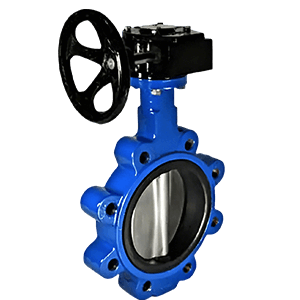Introduction
In the world of fluid control, valves play a critical role in regulating flow, pressure, and direction within pipelines. Among the many types available, butterfly valves have earned a prominent place due to their compact design, versatility, and cost-effectiveness. Found in industries as diverse as water treatment, HVAC, marine, power generation, and chemical processing, butterfly valves are designed to deliver reliable performance across a broad spectrum of applications.
Unlike bulkier alternatives such as gate or globe valves, butterfly valves are lightweight, require less installation space, and can handle large-diameter pipelines with ease. This article explores the essential aspects of butterfly valves — from their design and working principles to their types, advantages, limitations, and applications
Basic Design & Working Principle
Main Components
A butterfly valve is relatively simple in design but highly effective in operation. Its essential components include:
-
Body – Usually circular, designed to fit between two pipe flanges.
-
Disc – The core element that rotates to open or restrict flow.
-
Stem (or shaft) – Connects the actuator or handle to the disc, transmitting torque.
-
Seat – Provides sealing between the disc and valve body, often made of elastomers or other resilient materials.
-
Actuator or handle – Used to rotate the disc, which may be manual, pneumatic, electric, or hydraulic.
How It Works
The principle of operation is straightforward: rotating the disc a quarter turn (90°) shifts the valve from fully open to fully closed.
-
In the open position, the disc is parallel to the flow, minimizing resistance.
-
In the closed position, the disc is perpendicular, blocking flow entirely.
This quarter-turn action enables quick operation compared to rising stem gate valves or globe valves, which require multiple turns.

Types of Butterfly Valves
Concentric (Resilient-Seated) Butterfly Valve
-
Design: The disc sits centrally inside the body, with the stem passing through the disc’s centerline.
-
Sealing: Achieved by the disc compressing against a soft elastomer seat.
-
Applications: Common in water supply, HVAC, and wastewater treatment, where pressures and temperatures are moderate.
-
Advantages: Simple, cost-effective, lightweight.
Double Eccentric (High-Performance) Butterfly Valve
-
Design: The disc sits centrally inside the body, with the stem passing through the disc’s centerline.
-
Sealing: Achieved by the disc compressing against a soft elastomer seat.
-
Applications: Common in water supply, HVAC, and wastewater treatment, where pressures and temperatures are moderate.
-
Advantages: Simple, cost-effective, lightweight.
Triple Eccentric (Metal-Seated) Butterfly Valve
-
Design: The disc sits centrally inside the body, with the stem passing through the disc’s centerline.
-
Sealing: Achieved by the disc compressing against a soft elastomer seat.
-
Applications: Common in water supply, HVAC, and wastewater treatment, where pressures and temperatures are moderate.
-
Advantages: Simple, cost-effective, lightweight.

Materials & Construction
Body Materials
-
Cast iron – Economical, widely used in water systems.
-
Ductile iron – Stronger than cast iron, offering improved pressure ratings.
-
Carbon steel – Suitable for higher pressure and temperature services.
-
Stainless steel – Provides corrosion resistance in chemical and marine environments.
Disc Materials
-
Stainless steel – Corrosion-resistant, commonly used across industries.
-
Bronze or aluminum bronze – Good for seawater applications.
-
Nickel alloy – Withstands extreme chemical exposure.
Seat Materials
-
EPDM (Ethylene Propylene Diene Monomer) – Excellent for water, not suitable for hydrocarbons.
-
NBR (Nitrile Rubber) – Resistant to oils and fuels.
-
PTFE (Polytetrafluoroethylene) – Chemically inert, used in aggressive chemical services.
-
Metal seats – Essential for high-temperature applications.
Advantages of Butterfly Valves
-
Compact and lightweight – Requires less installation space than gate or globe valves.
-
Cost-effective – Lower material and manufacturing costs, especially in larger diameters.
-
Quick operation – Quarter-turn movement enables fast open/close.
-
Good flow regulation – While primarily isolation valves, they can also throttle flow.
-
Versatility – Can be used in liquid, gas, and slurry applications.
-
Low pressure drop – When fully open, the disc causes minimal resistance to flow.
-
Adaptability – Available in wafer, lug, and flanged designs for different pipeline configurations.

Limitations & Challenges
-
Pressure and temperature limitations – Resilient-seated designs are not suitable for extreme conditions.
-
Sealing challenges – In some applications, achieving bubble-tight shutoff can be difficult.
-
Throttling limitations – Extended throttling at partial openings can cause disc vibration and cavitation.
-
Potential obstruction – Even when fully open, the disc remains in the flow path, which may restrict certain sensitive systems.
Understanding these limitations is critical in selecting the right valve type for specific processes.
Applications Across Industries
-
Water Supply and Wastewater Treatment – Isolation and flow regulation in pipelines, reservoirs, and treatment plants.
-
Power Generation – Cooling water, fuel handling, and steam services.
-
Chemical and Petrochemical Plants – Handling aggressive chemicals with PTFE- or metal-seated designs.
-
Marine and Shipbuilding – Seawater systems, ballast control, fire protection.
-
HVAC and Building Systems – Efficient flow control in chilled water, heating, and ventilation systems.
Their ability to handle large diameters at lower costs makes them indispensable in infrastructure projects and industrial plants.
Selection Criteria
-
Valve Type – Concentric, double eccentric, or triple eccentric, depending on pressure and temperature needs.
-
Material Compatibility – Body, disc, and seat materials must suit the fluid medium.
-
Size and Pressure Class – Ensure compliance with pipeline specifications and standards.
-
Sealing Requirements – Decide whether soft-seated or metal-seated sealing is necessary.
-
Actuation Method – Manual, pneumatic, electric, or hydraulic, depending on automation needs.
-
Standards and Certifications – Verify compliance with ISO, API, ASME, or marine classification standards as applicable.
Post time: Sep-22-2025
